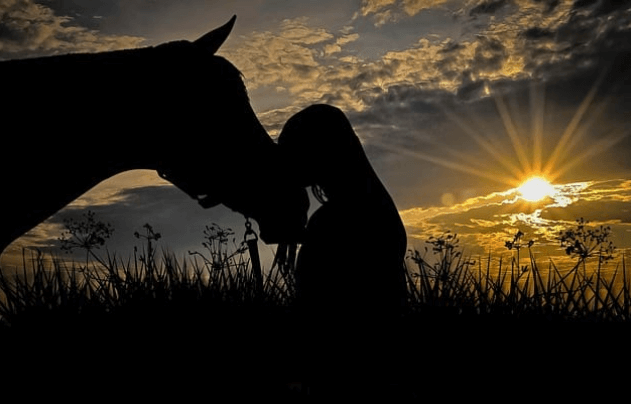Horses cannot see in total darkness like we do; their night vision is impressive in low light conditions. Despite having excellent night vision, in pitch-black darkness, horses are as blind as we are.
Horses’ vision, particularly their ability to see in the dark, is a fascinating topic that sheds light on the unique adaptations of these magnificent animals. While humans struggle in the dark, horses possess superior night vision capabilities that allow them to navigate low-light environments with ease.
Understanding how horses see in the dark not only provides insight into their natural abilities but also enhances our appreciation for their stunning visual acuity. We will delve deeper into the mysteries of equine night vision and uncover the secrets behind their remarkable ability to see in the dark.

The Science Of Horse Vision
Horses’ Night Vision Abilities
Horses possess remarkable night vision capabilities that set them apart from humans. In dim lighting conditions, they can see much better than we can due to their unique ocular adaptations.
- Horses have large eyes with a wide field of view.
- The tapetum lucidum, a reflective layer behind their retinas, enhances their night vision.
- They have a high concentration of rod cells in their retinas, which are sensitive to low light.
Factors Affecting Horse Vision
Several factors influence a horse’s vision, affecting their ability to perceive their surroundings with clarity:
- Light Conditions: Horses excel in low-light settings but struggle in complete darkness.
- Eye Anatomy: Large pupils and the tapetum lucidum enhance their vision in dim light.
- Color Perception: Horses can’t see red hues but have excellent blue and yellow color vision.
- Field of View: Their wide field of vision aids in detecting predators and obstacles.
Debunking The Myths
Debunking the Myths:
Can Horses See In Absolute Darkness?
No, horses don’t come with built-in night goggles. In absolute darkness, they’re as blind as we are. While their night vision is impressive in low light, in total darkness, they might as well be looking for a needle in a haystack.
Comparing Horse Night Vision With Humans’
Horses have excellent night vision. Horse eyes are large, they have a large pupil, and this allows ample amount of light to enter even in dark situations. On a night lit by a partial moon or stars, horses can see just as well as people can in full daylight.
Understanding Equine Eyes
The Structure Of Horse Eyes
Horses have large, prominent eyes that are positioned on the sides of their head. This placement allows them to have a wide field of vision, almost 350 degrees. The cornea, iris, and lens makeup the outer structure of the horse’s eye. The cornea is the transparent outer layer that protects the eye and helps in focusing light. The iris, which gives horses their distinctively beautiful eyes, controls the amount of light entering the eye.
The Role Of Tapetum Lucidum
A crucial component of understanding equine night vision is the tapetum lucidum, a layer of cells located behind the retina. The tapetum lucidum reflects light back through the retina, making it possible for the photoreceptor cells to have a second opportunity to register the incoming light. This results in enhanced light sensitivity and improved vision in low-light environments. The tapetum lucidum is responsible for the characteristic “glow” seen in horses’ eyes when illuminated at night.

Practical Implications
Horses have excellent night vision and can see as well as humans in moonlit or starlit conditions. Their large eyes and highly sensitive tapetum lucidum help them navigate in low light. However, in total darkness, they are as blind as humans.
This knowledge has practical implications for handling and riding horses in low light conditions.
Night-time Activities For Horses
If you’ve ever wondered about the night-time activities of horses, their superior night vision comes into play. Horses have the ability to see in low light conditions, allowing them to engage in various activities even when the sun goes down. In fact, horses are often more active during the night, taking advantage of their excellent night vision to explore their surroundings and graze on the plentiful grass that may be unavailable during the day. This natural behavior of horses can be observed in wild herds, where they rely on their night vision to navigate and find food in the darkness.
Ensuring Safety In Low-light Environments
While horses possess remarkable night vision, it’s essential for horse owners to take precautions and ensure their safety in low-light environments. This is especially true when handling horses during the night or when riding in dimly lit areas. Here are a few practical tips to ensure safety:
- Use reflective gear: When riding or handling horses in low-light conditions, it’s crucial to use reflective gear to make them more visible to others. Reflective strips on the horse’s halter, bridle, and rider’s clothing can significantly enhance their visibility, reducing the risk of accidents.
- Install adequate lighting: If you have horse stables or turnout areas where your horses spend time during the night, it’s important to ensure proper lighting for their safety. Well-lit areas can help horses navigate and reduce the chances of injuries.
- Secure fencing and obstacles: Inspect and secure the fencing and any potential obstacles on your property to minimize the risk of your horse stumbling or colliding with objects during the night. Regular maintenance and repair are essential to ensure a safe environment for your horses in low-light conditions.
- Provide night-friendly turnout: If your horses are turned out during the night, ensure the pasture or turnout area is free from hazards and well-maintained. Regularly check for any obstacles, ensure fencing is secure, and provide adequate shelter to protect them from the elements.
Remember, even though horses have outstanding night vision, it’s essential to take additional precautions to ensure their safety and prevent accidents in low-light environments. By implementing these practical measures, you can provide a secure and comfortable environment for your horses during the night.
Conclusion And Care Recommendations
Horses possess exceptional night vision, seeing effectively in low light conditions. However, in total darkness, they rely on minimal light sources or struggle like humans. Providing adequate lighting and a familiar environment can enhance their vision in the dark. Take proper care to optimize their natural abilities.
Optimizing Care For Horses’ Vision
Understanding horses’ vision is essential for providing proper care and ensuring their well-being. Although horses have excellent night vision, they cannot see in total darkness. It is crucial to create a safe and well-lit environment, especially during the night, to prevent accidents and minimize stress for these magnificent animals.
- Stable Lighting: Ensure adequate artificial lighting in horse stables and barns to provide a comfortable and visible space for the horses. This will help reduce the risk of accidents caused by unseen obstacles in the dark.
- Pasture Management: Keep pastures free from potential hazards such as uneven ground, holes, or dangerous objects that can pose a threat to horses during their nightly activities.
- Regular Veterinary Check-ups: Schedule regular check-ups with a veterinarian to monitor your horse’s overall health, including their vision. Early detection of any eye-related problems can prevent further complications.
- Feed and Supplements: Provide a balanced diet rich in essential nutrients to promote optimal eye health in horses. Consult with a veterinarian or equine nutritionist for a diet plan suitable for your horse’s specific needs.
- Protective Eyewear: Consider using fly masks or UV-blocking goggles to protect your horse’s eyes from harmful UV rays, dust, and flying debris. This is particularly important during sunny days or when riding in dusty environments.
Key Takeaways
- Horses have impressive night vision but cannot see in complete darkness.
- A well-lit environment, both indoors and outdoors, is crucial for horse safety during nighttime activities.
- Regular veterinary check-ups and a balanced diet are essential for maintaining optimal eye health in horses.
- Consider using protective eyewear, such as fly masks or goggles, to shield your horse’s eyes from potential hazards.

Frequently Asked Questions For Can Horses See In The Dark
Can Horses See In Total Darkness?
Horses cannot see in total darkness; their night vision is impressive in low light but not in pitch-black.
Do Horses See Better At Night?
Yes, horses have excellent night vision, allowing them to see well in low-light conditions. However, they cannot see in pitch-black darkness like we do. Their large eyes and tapetum lucidum help them see as well as humans in moonlit or starlit environments.
What Color Can Horses See?
Horses can see blue, green, and variations of these colors, but they cannot see red or shades of red. They have excellent night vision but cannot see in absolute darkness. In low light conditions, their night vision is impressive, but in pitch-black darkness, they are as blind as humans.
How Much Can Horses See In The Dark?
Horses have excellent night vision, but they cannot see in absolute pitch darkness. Their large eyes and pupils allow enough light to enter, allowing them to see well in low-light conditions. In a night lit by a partial moon or stars, horses can see just as well as humans can in full daylight.
Conclusion
Horses have impressive night vision, allowing them to see well in low light conditions. However, in total darkness, their vision is limited, much like humans’. Understanding the capabilities and limitations of a horse’s sight can be crucial for their well-being and safety, especially during nighttime activities.

